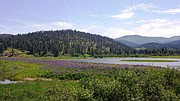'A particularly deadly season for swans' in the Cd'A River Basin
Panhandle Region Fish and Game staff have received numerous calls about dead tundra swans in the lower Coeur d’Alene River Basin, particularly around Harrison Slough. The deaths are attributed to poisoning from mine waste contamination found in the wetland sediments where the birds forage.
Each spring, an average of 150 tundra swans are found dead or sick along the Coeur d’Alene River floodplain.
The spring of 2019 is shaping up to be a particularly deadly season for swans killed by contaminant exposure. This may be due to a combination of factors, including timing and distribution of ice melt, water levels in the floodplain, and length of time the migrating swans stayed in the area while on their way to breeding grounds in Alaska.
For most of the 20th century, mining waste was discharged into the Coeur d’ Alene River and its tributaries. This caused metals like lead to accumulate in many of the marsh soils along the river. Around 95 percent of wetland habitat in the lower Coeur d’Alene River Basin contains lead levels toxic to swans and other waterfowl.
Efforts to reduce contamination exposure in tundra swans and other wildlife are led by the Restoration Partnership, of which Fish and Game is a partner. In 2018, the Partnership completed a comprehensive restoration plan that laid out a strategic framework for restoring natural resources, such as waterfowl, that are impacted by the release of historic mine waste. Approximately $140 million is available from settlements to implement the plan.
“Seeing these swans continues to put all this [work] in perspective and reinforces the urgency and importance of what we’re doing” said Kajsa Van de Riet, a Restoration Partnership technical staff member from Idaho Department of Environmental Quality.
While other birds, such as Canada geese and ducks, can be affected by the historic mine waste, tundra swans are particularly vulnerable because they burrow deep into the mud to feed on roots and tubers, increasing the amount of exposure to dangerous contaminants like lead that are bound to the soil.
Short-term measures to prevent swan deaths include deterring the birds from landing in heavily contaminated areas and raising water levels to make it harder for the birds to reach contaminated sediments. Long-term efforts are focused on habitat restoration projects that provide clean, healthy foraging and nesting areas.
These large-scale habitat restoration efforts have already begun. Starting in 2006, the Restoration Partnership led a 400-acre restoration project on private farm lands near Rose Lake, providing clean marsh habitat for swans and other wildlife. In 2015, Fish and Game habitat specialists restored another 65 acres of wetlands adjacent to this property in the Robinson Creek Project with funding support from the Idaho Department of Environmental Quality, EPA, and the Partnership.



